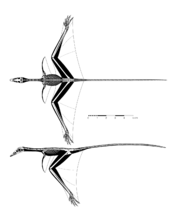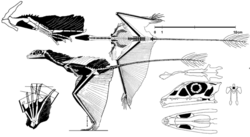
Sharovipteryx
Encyclopedia
Sharovipteryx was an early gliding reptile, from the middle-late Triassic
period (230-225 million years ago). Fossils have been found from the Madygen Formation of Kyrgyzstan
along with the unusual reptile Longisquama
. It was approximately eight inches (20 cm) long, with an extremely long tail, and weighed about 7.5 grams. It may have been closely related — or perhaps even ancestral — to pterosaur
s, although this remains controversial. Unlike pterosaurs, its main flight membrane was stretched between long back legs rather than its very short front limbs.

 If Sharovipteryx was a relative of pterosaurs, then its membrane may have stretched to its front legs, or it may have had a separate membrane joined to its front limbs alone. A secondary membrane is visible between the thighs and the trunk. Front wing membranes have not been seen; Peters (2006) has claimed to have traced the fingers and that they show similarities to Cosesaurus and Longisquama
If Sharovipteryx was a relative of pterosaurs, then its membrane may have stretched to its front legs, or it may have had a separate membrane joined to its front limbs alone. A secondary membrane is visible between the thighs and the trunk. Front wing membranes have not been seen; Peters (2006) has claimed to have traced the fingers and that they show similarities to Cosesaurus and Longisquama
and to a lesser extent, pterosaurs. Some scenarios have it as a leaping animal, which would spring up in the air and then control its fall with its "wings". This fits well with the belief that pterosaurs evolved from running, leaping ancestors, because some scientists believe they lacked adaptations for living in trees. However, others suggest that Sharovipteryx would run up a tree on its sharply clawed rear legs (its overall design seems poor for climbing), and then spring into the air. The forelimbs seem too short for quadrupedal running or climbing. Such a configuration was probably necessary in order to free the forelimbs from the task of walking and allow them to become something else.
Sharovipteryx was a biped. Compared to e.g. living lizards capable of bipedal running, Sharovipteryx had a better pelvis, more sacral vertebrae, longer hind limbs, a shorter torso and a thinner tail. The diminution of the tail muscles and the increase in the pelvic muscles might show that Sharovipteryx was on its way toward a pterosaur-like metabolism, probably homeothermic. It was not depending on torso undulations for locomotion and therefore not subject to Carrier's constraint
on breathing while running.
In 2006, Dyke et al. published a study on possible gliding techniques for Sharovipteryx. The authors found that the wing membrane, which stretched between its very long hind legs and tail, would have allowed it to glide in a manner similar to delta wing
aircraft. If the tiny front limbs also supported a membrane, they could have acted as a very efficient means of controlling pitch stability, very much like a canard
. Without a forewing, the authors find, controlled gliding would have been very difficult (unfortunately, the area around the forelimbs was completely prepared away in the only known fossil, destroying any possible trace of a membrane there). Together with the canards on the forelimbs, these anterior membranes may have formed excellent control surfaces for gliding.
Sharov in 1971 illustrated the finger tips to the elongated digit IV in both hands.
Triassic
The Triassic is a geologic period and system that extends from about 250 to 200 Mya . As the first period of the Mesozoic Era, the Triassic follows the Permian and is followed by the Jurassic. Both the start and end of the Triassic are marked by major extinction events...
period (230-225 million years ago). Fossils have been found from the Madygen Formation of Kyrgyzstan
Kyrgyzstan
Kyrgyzstan , officially the Kyrgyz Republic is one of the world's six independent Turkic states . Located in Central Asia, landlocked and mountainous, Kyrgyzstan is bordered by Kazakhstan to the north, Uzbekistan to the west, Tajikistan to the southwest and China to the east...
along with the unusual reptile Longisquama
Longisquama
Longisquama insignis is an extinct lizard-like reptile known only from one poorly preserved and incomplete fossil. It lived during the middle or late Triassic Period, 230-225 million years ago, in what is now Kyrgyzstan...
. It was approximately eight inches (20 cm) long, with an extremely long tail, and weighed about 7.5 grams. It may have been closely related — or perhaps even ancestral — to pterosaur
Pterosaur
Pterosaurs were flying reptiles of the clade or order Pterosauria. They existed from the late Triassic to the end of the Cretaceous Period . Pterosaurs are the earliest vertebrates known to have evolved powered flight...
s, although this remains controversial. Unlike pterosaurs, its main flight membrane was stretched between long back legs rather than its very short front limbs.


Longisquama
Longisquama insignis is an extinct lizard-like reptile known only from one poorly preserved and incomplete fossil. It lived during the middle or late Triassic Period, 230-225 million years ago, in what is now Kyrgyzstan...
and to a lesser extent, pterosaurs. Some scenarios have it as a leaping animal, which would spring up in the air and then control its fall with its "wings". This fits well with the belief that pterosaurs evolved from running, leaping ancestors, because some scientists believe they lacked adaptations for living in trees. However, others suggest that Sharovipteryx would run up a tree on its sharply clawed rear legs (its overall design seems poor for climbing), and then spring into the air. The forelimbs seem too short for quadrupedal running or climbing. Such a configuration was probably necessary in order to free the forelimbs from the task of walking and allow them to become something else.
Sharovipteryx was a biped. Compared to e.g. living lizards capable of bipedal running, Sharovipteryx had a better pelvis, more sacral vertebrae, longer hind limbs, a shorter torso and a thinner tail. The diminution of the tail muscles and the increase in the pelvic muscles might show that Sharovipteryx was on its way toward a pterosaur-like metabolism, probably homeothermic. It was not depending on torso undulations for locomotion and therefore not subject to Carrier's constraint
Carrier's constraint
Carrier's constraint is the observation that air-breathing vertebrates which have two lungs and flex their bodies sideways during locomotion find it very difficult to move and breathe at the same time, because:...
on breathing while running.
In 2006, Dyke et al. published a study on possible gliding techniques for Sharovipteryx. The authors found that the wing membrane, which stretched between its very long hind legs and tail, would have allowed it to glide in a manner similar to delta wing
Delta wing
The delta wing is a wing planform in the form of a triangle. It is named for its similarity in shape to the Greek uppercase letter delta .-Delta-shaped stabilizers:...
aircraft. If the tiny front limbs also supported a membrane, they could have acted as a very efficient means of controlling pitch stability, very much like a canard
Canard (aeronautics)
In aeronautics, canard is an airframe configuration of fixed-wing aircraft in which the forward surface is smaller than the rearward, the former being known as the "canard", while the latter is the main wing...
. Without a forewing, the authors find, controlled gliding would have been very difficult (unfortunately, the area around the forelimbs was completely prepared away in the only known fossil, destroying any possible trace of a membrane there). Together with the canards on the forelimbs, these anterior membranes may have formed excellent control surfaces for gliding.
Sharov in 1971 illustrated the finger tips to the elongated digit IV in both hands.
External links
- First Delta-Wing Fighter Was a Reptile - LiveScience.com
- JPG of the fossil from the Russian paleontological museum - Paleo.ru

